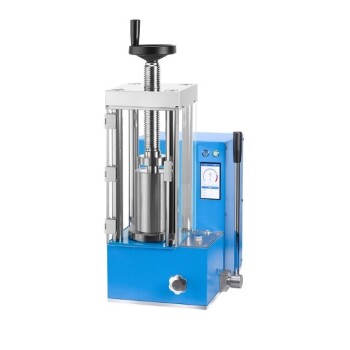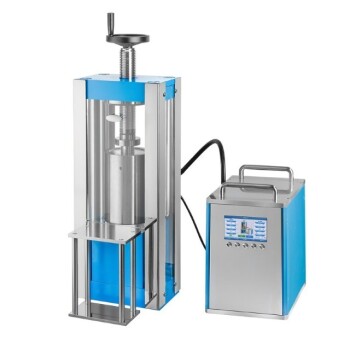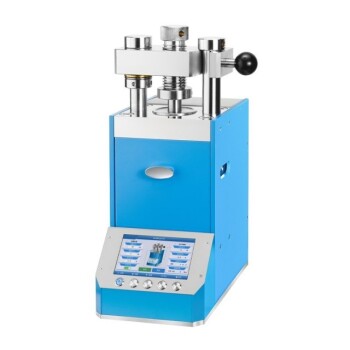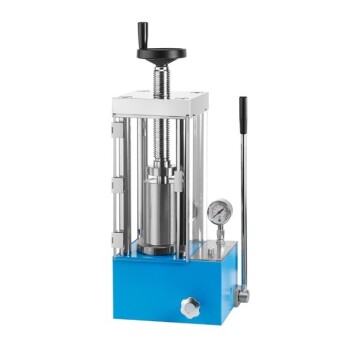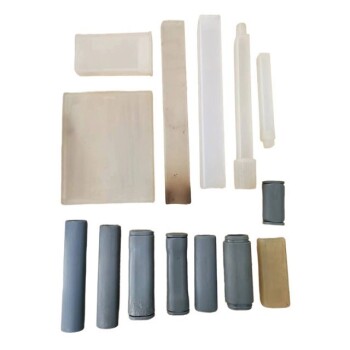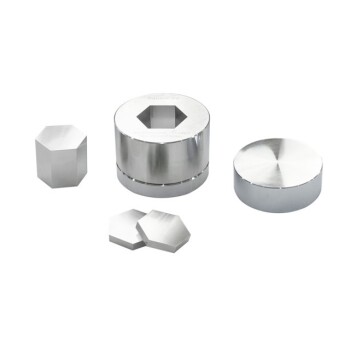At its core, the absence of die-wall friction is the single greatest advantage of isostatic compaction. This fundamental difference allows for the creation of powder compacts with exceptionally uniform density, which directly eliminates the process complexities and quality issues associated with lubricants required in traditional pressing methods.
While traditional compaction fights against friction, isostatic compaction sidesteps it entirely. By applying pressure uniformly through a fluid, it ensures every part of the powder compacts evenly, leading to a structurally superior component without the need for performance-compromising additives.
The Problem: Die-Wall Friction in Traditional Compaction
To understand why eliminating friction is so beneficial, we must first examine the problems it creates in conventional uniaxial (single-axis) pressing.
What is Die-Wall Friction?
In uniaxial pressing, a metal punch compresses powder within a rigid metal die cavity. As the punch moves, the powder particles are forced against the stationary die walls.
Die-wall friction is the resistive force that arises between the moving powder mass and these rigid walls.
The Consequence: Density Gradients
This friction opposes the compaction force. The pressure applied by the punch is highest near the punch face and progressively decreases deeper into the die.
This results in a density gradient, where the part is densest at the top and bottom and least dense in the middle. These variations create internal stresses, leading to defects like cracking or warping during sintering (heating).
The Lubricant Dilemma
To mitigate this friction, lubricants are mixed with the powder. However, this is an imperfect solution that introduces its own set of significant problems.
The lubricant must be completely removed, typically by a slow heating or "burnout" phase, before the final sintering. Incomplete removal can lead to contamination, porosity, and poor final part quality.
How Isostatic Compaction Eliminates Friction
Isostatic compaction re-engineers the entire process to avoid the root cause of friction.
The Principle of Isostatic Pressure
Instead of a rigid die and punch, the powder is placed in a flexible, sealed mold. This mold is then submerged in a fluid (liquid or gas) inside a pressure vessel.
The fluid is pressurized, transmitting force equally and simultaneously to all surfaces of the flexible mold. This is the definition of isostatic—"uniform pressure from all sides."
No Rigid Die, No Friction
Because pressure is applied by a fluid and the powder is contained in a flexible tool, there is no relative movement between the powder and a rigid die wall.
This simple but profound change completely eliminates die-wall friction as a factor in compaction.
The Result: Highly Uniform Density
Since every particle within the powder mass experiences nearly identical compressive force from all directions, the resulting "green" part has a remarkably uniform density throughout its entire volume.
This uniformity is the key to achieving superior material properties in the finished component.
Understanding the Downstream Benefits
Eliminating friction and density gradients has several powerful, practical benefits that directly impact process efficiency and final part quality.
Higher and More Consistent Final Properties
A uniformly dense green part shrinks predictably and evenly during sintering. This minimizes internal stresses, prevents warping, and results in a final component with consistent mechanical properties. It also allows for higher overall pressed densities at a given pressure.
Elimination of Lubricant Removal
Because no lubricants are needed, the entire lubricant burnout step is removed from the manufacturing process. This saves significant time, reduces energy consumption, and eliminates a common source of defects and contamination.
Superior for Challenging Materials
Brittle materials or very fine powders are particularly sensitive to the non-uniform stress caused by die-wall friction, which can lead to micro-cracks. The gentle, uniform pressure of isostatic compaction is ideal for pressing these challenging materials without introducing flaws.
Common Pitfalls and Considerations
While powerful, isostatic compaction is not a universal solution. Understanding its trade-offs is critical for making an informed decision.
Tooling Complexity and Cost
The flexible molds used in isostatic pressing are typically less durable and more complex to design and fabricate than the hardened steel dies used in uniaxial pressing. This can lead to higher tooling costs per part.
Cycle Times
Isostatic pressing is often a batch or semi-continuous process, involving loading and unloading a pressure vessel. It generally has longer cycle times compared to the high-speed, continuous nature of automated uniaxial presses.
Dimensional Tolerance
While density uniformity is excellent, achieving the same tight dimensional precision as a part formed in a rigid, high-precision die can be more challenging. The flexibility of the mold can lead to slightly less dimensional repeatability.
Making the Right Choice for Your Goal
Ultimately, the choice between isostatic and traditional compaction depends on the specific requirements of your component.
- If your primary focus is maximum density uniformity and final part integrity, especially for complex shapes: Isostatic compaction is the superior technical choice, as it eliminates the root cause of many defects.
- If your primary focus is high-volume production of simple shapes where cost-per-part and speed are paramount: Traditional uniaxial pressing is often the more economical solution, provided you can manage the effects of friction.
- If your primary focus is processing sensitive, brittle, or fine powders without contamination: The lubricant-free, uniform pressure of isostatic compaction offers a decisive process advantage.
Choosing the correct compaction method is a crucial step in engineering a component that reliably meets its performance targets.
Summary Table:
| Aspect | Isostatic Compaction | Traditional Compaction |
|---|---|---|
| Die-Wall Friction | None | Present, causes density gradients |
| Density Uniformity | High and uniform | Variable, with gradients |
| Lubricant Use | Not required | Required, adds complexity |
| Part Defects | Reduced risk of cracking/warping | Higher risk due to friction |
| Ideal For | Complex shapes, brittle materials | Simple shapes, high-volume production |
Upgrade your lab's powder compaction with KINTEK's advanced isostatic presses! Our automatic lab presses, including isostatic and heated models, deliver uniform density and eliminate lubricant issues for superior results in research and development. Contact us today to discuss how our solutions can enhance your material processing and boost efficiency.
Visual Guide
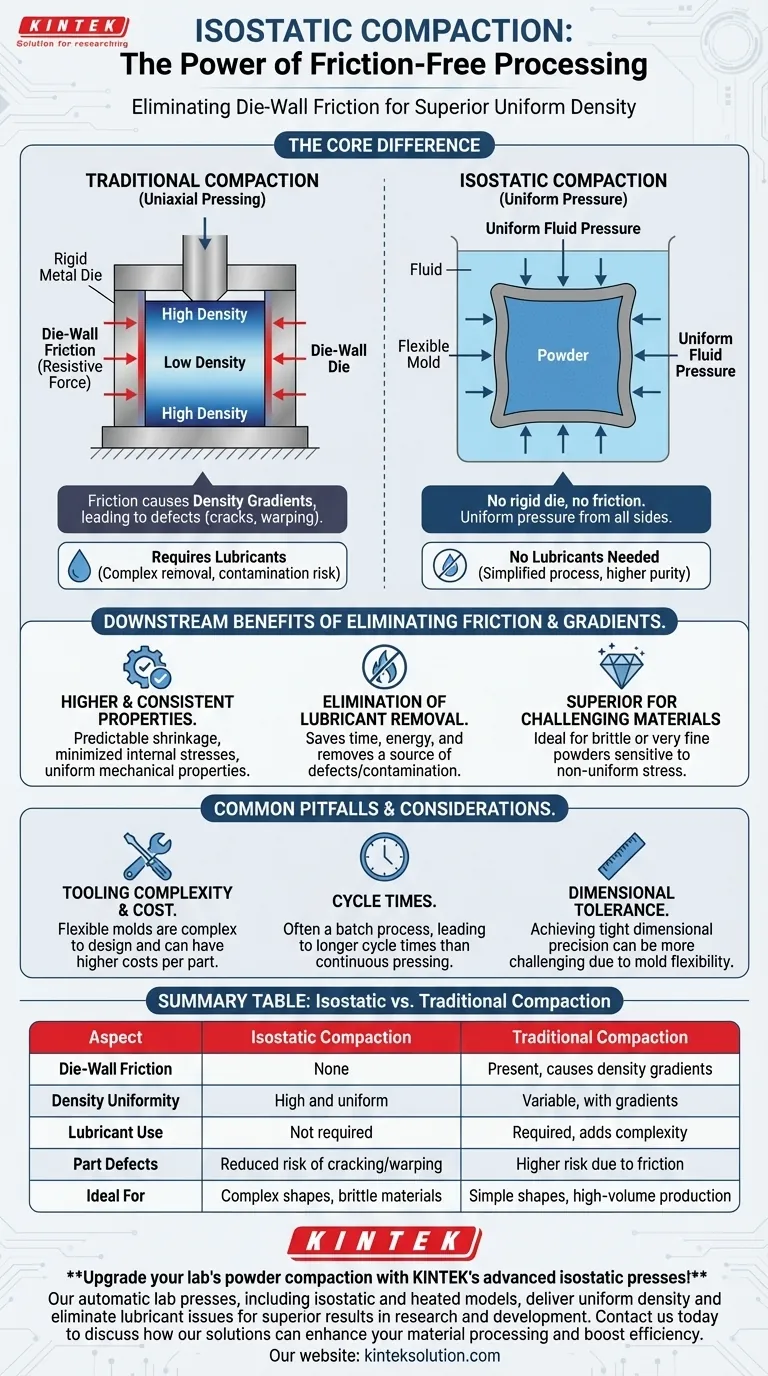
Related Products
- Electric Lab Cold Isostatic Press CIP Machine
- Electric Split Lab Cold Isostatic Pressing CIP Machine
- Automatic Lab Cold Isostatic Pressing CIP Machine
- Manual Cold Isostatic Pressing CIP Machine Pellet Press
- Lab Isostatic Pressing Molds for Isostatic Molding
People Also Ask
- What are the two main techniques used in cold isostatic pressing? Wet-Bag vs. Dry-Bag Methods Explained
- What are the advantages of Cold Isostatic Pressing for ceramic production? Achieve Uniform Density and Complex Shapes
- What are the advantages of uniform density and structural integrity in CIP? Achieve Superior Performance and Reliability
- What are the characteristics of the isostatic pressing process? Achieve Uniform Density for Complex Parts
- In which industries is CIP commonly applied? Discover Key Sectors Using Cold Isostatic Pressing
